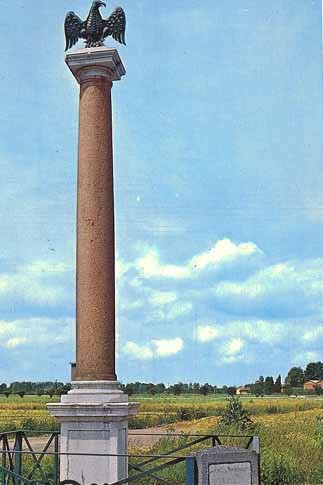The Battle of Marengo took place on the Bormida plain on 14 June 1800, near to the town of Alessandria in Piedmont. The French Arméé de Réserve led by the First Consul fought against the Austrian troops of the Second Coalition. Never was victory so close to defeat.
The combat began at 9 am with the Austrian attack. At 2pm, the situation for the French was so critical, and getting worse by the hour, that FeldMarschal Melas decided to leave the battlefield to return to Alessandria to announce the victory, leaving Kaim in command. But Kaim's pursuit was weak and the French were given the chance to make an ordered retreat, whilst the divisions of Desaix and Boutet arrived at 5pm. Bonaparte at that point managed to halt the French retreat and to relaunch an offensive. It was at this point that Desaix's famous charge took place at the head of the 9e demi-brigade légère during the paintings, sculptures, commemorative monuments, tomb at the top of the Great Saint Bernard Pass) all magnifying the glory of the Napoleonic hero.
A house was built on the site at Marengo, about 2.5km from Alessandria via via Marengo and then via Genova, christened Villa Marengo. Built in 1847 by Giovanni Dellavo, the villa has a trompe-l'oeil façade and houses the Museum of the Battle of Marengo, which includes a collection of arms belonging to the Napoleonic Society of Marengo (founded in 1992), various objects of historical significance and a large model of the battle. In front of the villa stands a statue in pink granite of the First Consul, by the sculptor Benito Cacciatori (1847), supposedly with the head turned towards the place where Desaix fell. At the edge of the park stands the ossarium containing the bones of those who died during the battle. There is also a bust of General Desaix.
Here there is also a commemorative column, erected by the town on the first anniversary of the battle. It is topped with an eagle and bears the Latin and Italian inscription which translated reads: “Here at Marengo/on 14 June 1800/Bonaparte First Consul /of the French Republic/led his army /to victory “. Taken down in 1814 by the Austrians, it was moved to Fiume, and re-erected in a private villa at the end of the First World War. It was returned to Marengo in 1922 after a brief period at the Bormida Fort.
In the town of Alessandria, the Cittadella was the H.Q. for Melas and the Austrian army. The Bormida, which runs along the edge of the town, was in fact the line of demarcation between the opposing armies. It was crossed by the Austrian army first of all in the morning of 14 June and crossed again in the evening in the opposite direction by the retreating Austrian army. The majestic plane tree known as “Napoleon's Plane” is traditionally thought to have been the place where Bonaparte once rested in its shade. Since the tree was most probably behind Austrian lines, it would appear more likely that it was the last in a commemorative avenue which led from Marengo to Alessandria.
Bonaparte's H.Q. on the other hand was in a large farm at Torre di Garofoli, in the direction of Tortona. He also slept there the night after the battle. A plaque in Italian bears the inscription: “In this town /the First Consul Bonaparte/planned the Battle of Marengo/which he passed victoriously /on 14 June 1800./Here the heroic General Desaix/mortally wounded in the fight/ breathed his last./ Bonaparte signed the Alessandria Agreement/which stipulated that from the evening of the 15th/Lombardy, Piedmont, and Liguria would be returned to France./Held at Torre Garofoli./Alexandre Guibono Cavalchini Garofoli baron S.R.I./placed this plaque here in September 1905”.
Marengo


